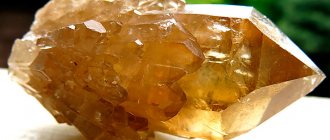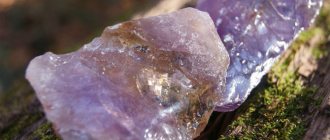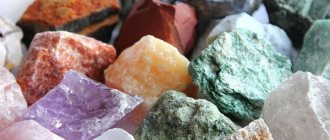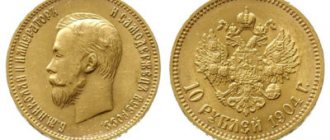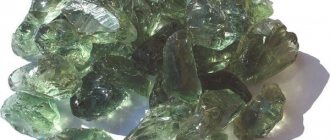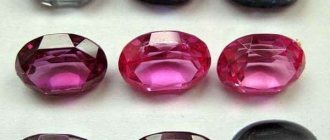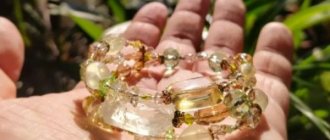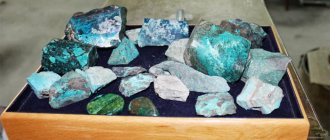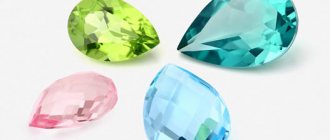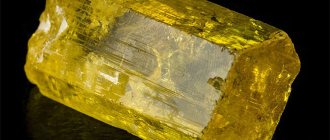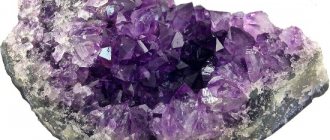History and origin
Citrine is a rare variety of quartz. For jewelers, the honey-golden nugget is classified as class IV precious stones. Citrine differs from ordinary quartz only in color. The closest minerals to it are pink, smoky and transparent varieties of quartz, as well as morion, amethyst and rock crystal.
The ancient peoples once revered citrine for its magical abilities. The Greeks and Romans made golden quartz a talisman for politicians and orators, because they believed that with the help of the stone they acquired the gift of eloquence. But African and South American aborigines used the stone as amulets against poisonous snakes.
Not so long ago, at the turn of the 19th and 20th centuries, citrine was popular among businessmen, officials, merchants, and other members of the nobility. The stone was used to complement gold personal seals used to seal letters or documentation.
Do you know that although golden quartz has been known since ancient times, the stone took its own name and place in mineralogy only in the 17th century, when in 1747 the chemist Valerius officially introduced the nugget into scientific literature.
Since that time, citrine has become fashionable in the royal chambers and among representatives of the upper class. They began to make all kinds of jewelry from the gem, as well as to complement royal crowns and other symbols of power.
The name of the gem is derived from the Latin word “citrus”, which means “lemon”, reflecting the main color of the gem. Until this turning point, a lemon nugget, depending on its color, was mistaken for golden or Spanish topaz, although the physical properties of citrine are significantly different. And these days, specimens with a greenish tint are mistaken for light-colored emeralds.
Beautiful citrine stone - the golden kiss of the Sun
The end of summer has come, although the yellow leaves are not yet visible and the sun is shining brightly, soon golden leaves, the first cobwebs, a deep autumn sky will appear, and all this will delight us until the golden autumn. Therefore, to raise morale, we decided to write for you, dear guests and masters of the Masters Fair, an article about such a beautiful and cheerful stone as citrine. Its bright orange-honey color will lift your spirits in any situation, inspire new creative achievements, and when you involuntarily look at a piece of jewelry with citrine, you will immediately forget about everything gloomy and bad, since it will be a personal piece of sunshine.
Citrine is a crystalline variety of quartz with yellow hues, found in the form of well-formed transparent crystals. It is found in hydrothermal formations, sometimes in sedimentary rocks. The name citrine comes from the French "citron" - lemon, or from the Latin word "citrus" - lemon. Citrine crystals are mined in Brazil, Spain, and Madagascar. Small specimens of citrine were found in the vicinity of Jelenia Gora in Poland.
In terms of color characteristics and transparency, citrine is close to topaz, therefore the word “topaz” often appears in the trade names of citrine - Bohemian topaz, Brazilian topaz, oriental topaz, false topaz, pseudotopaz. Golden-yellow citrines are sometimes called golden topaz, and brownish-yellow citrines are sometimes called Spanish topaz. Madeira topaz, bahia topaz, palmyra topaz, and sierra topaz are all trade names for citrine or burnt wine-yellow amethyst from deposits in Brazil. Madagascar citrine is a lemon-yellow topaz from Madagascar. Another ancient name for citrine is saffranitil and its distorted version is safronite (safranite). The name probably comes from the yellow “saffron” color.
The history of this solar quartz dates back to the Middle Ages. The term “citrine” was introduced into mineralogy in 1747 and has been known since 1556. Citrine cabochons can be seen in crowns, rings and other jewelry of rulers of the past, and in the 19th century, jewelry makers used the mineral to make the seals of important gentlemen. Due to the fact that this stone is rare in nature, back in the Middle Ages it was often obtained artificially by burning amethyst crystals.
Citrines acquire different shades from light lemon to intense brown-orange, depending on the proportion of iron impurities in their composition. By subjecting amethysts and some varieties of quartz to heat treatment, it is possible to obtain stones of a rich palette of shades, the most noble of which is called Madeira for the similarity of the shade to the deep and thick color of this type of wine. Stones refined in this way do not have the property of dichromism (they do not change shade depending on the viewing angle), but due to their purity and uniform color they resemble topaz. That is why the market is filled with analogues of the mineral, because the quality of refined stones is in no way inferior to natural ones.
By the color of the stone you can determine the nature of its appearance: the palest ones are real mountain citrines, and the brighter the stone, the more likely it is that it is another burnt quartz, for example, the orange tint is characteristic of singed amethyst. The stone born from nature does not have such an attractive and rich color as fired smoky quartz; transparency predominates in it.
Citrine is a valuable jewelry and collectible mineral; it belongs to IV order precious stones. Citrine is used to make brooches, earrings, pendants, and inserted into rings. In the old days, signet rings were often cut from citrine. For transparent varieties of citrine, diamond or combination cuts are used. For opaque ones - flat, polished stone feed. For stones with moss stains, use only cabochons.
Citrine was used not only as a jewelry insert for jewelry. They have long been used to decorate icons, stained glass windows, and clothes. Jewelry with citrines gained popularity several centuries ago, and still remains one of the favorites of jewelry makers. The material is not very difficult to process and does not require much effort to create a cut. Thanks to the rich kaleidoscope of its delicate colors, this quartz can be combined with absolutely any metal, and is in perfect harmony with other precious stones. The most advantageous option for citrine in a product is, of course, models made of white and yellow gold, and the best partner for inserts in the finished jewelry will be diamonds.
Most citrines that are sold are processed amethysts and smoky quartz. Similarity with them is achieved by calcining the amethyst. 500 degrees, after this treatment citrine has a stable yellow color. Smoky quartz and its varieties turn yellow when heated between 300 and 400 degrees. Citrines with heat treatment have a richer and thicker color, and also have a reddish tint. Natural citrines are usually light or pale yellow.
Jewelers, when choosing what shape and cut to give a stone, primarily focus on the transparency of quartz. If citrines do not contain internal defects or cracks, they are cut like diamonds and used for rings, earrings, brooches, and pendants. If the stone is heterogeneous, then its disadvantages turn into advantages when cut into cabochons and inlaid into bracelets and necklaces.
Larger clear-colored stones are used for brooches and pendants, while smaller quartz stones look great in rings, earrings, bracelets and many other jewelry designs.
This stone has no age restrictions; both young ladies and older ladies can wear jewelry with citrines. The mineral is not striking, but will not go unnoticed in any situation, be it an ordinary day, or some special event where numerous glances will be directed at your person. The stone goes perfectly not only with evening dresses, but will also highlight your individuality with its warmth every day at any time of the year.
Citrine is a stone with a long history and an established noble reputation. People used the mineral as amulets of luck, fertility and harmony. The mineral is the patron of the financial side of life; according to ancient beliefs, the owner of the stone attracted success and financial well-being. Fans of gambling believed that it brought good luck and preferred to wear signet rings to attract good fortune.
Due to its warm, honey-golden color, quartz is considered an object that has absorbed solar energy and eternal life, so everyday things (bracelets, beads) were often decorated with stones in order to maintain the inner harmony of the soul and tranquility of the body. Many speakers and public people had citrine inserts in their outfits and jewelry, so that the stone would help carry the necessary energy from the speaker’s speeches and contribute to the correct flow of thoughts.
Now let's admire the citrine jewelry 
Earrings:
Rings:
Pendants and pendants:
We hope you liked our article and were interested in learning something new for yourself. 
Physical properties
The chemical composition of citrine is silicon oxide, similar to quartz. The characteristic shades of yellow are provided by impurities of lithium, iron, aluminum or hydrogen. In nature, the mineral is formed in large crystals, often twinned, forming druses.
| Property | Description |
| Formula | SiO2 |
| Hardness | 7 |
| Density | 2.65 g/cm³ |
| Melting temperature | 1700˚С |
| singonia | Trigonal |
| Shine | Glass |
| Transparency | Transparent |
| Color | Shades of yellow or orange |
Interesting fact! The Smithsonian Institution holds a 22.9-carat processed citrine crystal.
The stone stored at the Institute
Natural citrine is transparent, endowed with shades of light yellow.
However, if a citrine crystal is heated to a certain temperature, the stone will acquire a more saturated yellow color. However, heat treatment deprives the nugget of pleochroism characteristic of an untreated stone.
Physicochemical properties of citrine
Natural citrine.
Photo: gemstonebuzz.com The color of the stone varies. It can be pale yellow, juicy lemon, bright honey. The color depends on the impurities, ferric iron, tetravalent silicon and ferric aluminum.
The chemical formula of the stone is SiO2. Cleavage is completely absent, the fracture is conchoidal.
Advertising - Continued below
Citrine is a transparent, shiny stone, a type of quartz, classified as a semi-precious stone.
Color varieties
The color palette of citrine begins with a pale yellow hue and ends with brownish-honey or amber. Gemologists often refer to light-colored stones as “Bohemian citrines” and darker varieties as “Spanish topaz.” Although in fact the natural mineral is close to the color of lemon, and all the brighter stones are thermally refined.
There is also light green citrine, which is popularly called false emerald. Such a gem has no value, since it quickly discolors from sunlight.
Also read: Jadeite - an ancient source of luck and inspiration
Pendant with false emerald
Ametrine, which is a mixture of Citrine and Amethyst, is considered a very rare, unique stone. In appearance, it is a striped mineral with alternating lilac amethyst and light yellow stripes. In mineralogy it is called amethyst-citrine quartz, this variety is found in Brazil.
Story
Citrine is a rare representative of the quartz family of minerals.
For centuries, the citrine stone did not have a name. It was considered and called topaz: Spanish, Bohemian, Western. The name was established in the 18th century and is translated from Latin and European languages as “lemon yellow.”
VIPs were decorated with gold-colored crystal seals for confidential documents.
Healing properties
In lithotherapy, the healing abilities of citrine extend to all organs located in the area of the umbilical chakra, as well as the solar plexus chakra. This means that the stone has a beneficial effect on the genitourinary system and organs of the gastrointestinal tract (liver, spleen, stomach, pancreas, intestines).
The energy of the stone is concentrated in the areas of these two chakras, which means that the mineral is especially useful for pregnant women and women wishing to become pregnant. In addition, citrine has a beneficial effect on the brain, improving concentration, memory and clarity of thinking.
The golden nugget can also cope with some unadvanced spinal diseases. The stone will have an analgesic effect in case of vertebral hernia, and will also enhance the effect of medications.
Citrine is able to calm emotional storms, overcome insomnia, and drive away nightmares. Lithotherapists advise using the mineral to eliminate problems with speech development in children. If the problem is not advanced, the gem will help the child cope with stuttering or other defects up to the age of 11.
Also, stone treatment specialists note the rehabilitative effect of the mineral on the human body after physical or psychological trauma. In the absence of its own energy, citrine promotes the rapid accumulation of the owner’s own vital energy, fighting back chronic fatigue.
It is worth remembering that only natural, pure minerals without the slightest dark inclusions or impurities have healing abilities.
Magic powers
The magic of citrine is versatile, although it has one main direction - gaining a person’s sociability. With such a talisman, anyone becomes a charismatic, confident, charming person. The stone endows the owner with oratorical talent, the gift of persuasion, and helps to establish new connections. Any argument or discussion becomes a winner, no matter how good the opponent is.
However, any medal still has two sides. The nature of citrine is such that the mineral does not distinguish people by character. He helps good and evil, people with pure intentions and swindlers at the same time. The receptive female energy of Yin helps to change a person’s personal qualities to suit society in such a way that the owner of the stone is liked by everyone, everywhere. This makes it easy for wicked people to ingratiate themselves by pulling off scams.
Thus, citrine favors people of such professions as businessmen, politicians, managers, and lawyers. Although he loves creative people no less, those engaged in crafts or any precision work - jewelers, surgeons, watchmakers.
Suspension
It is also believed that if the mother gives the baby a citrine amulet at birth, then such a talisman will protect the child throughout his life. The stone will protect the owner from any evil forces, misfortunes, and premature death.
Golden quartz has the power to resolve financial setbacks, improving your financial situation in the shortest possible time. This is a bonus for entrepreneurs.
The gem sharpens the intuition of an ordinary person, and also enhances the magical talent of clairvoyants. For the first, citrine helps to catch deception in a timely manner, thus avoiding trouble, and for the second, it helps to establish contacts with the world of spirits.
Citrine can be worn around the clock without parting with the talisman. The amulet can be either in the form of jewelry or simply in the form of a natural nugget crystal.
Also read: Chicken God - a pagan amulet against evil spirits
The video describes the magical properties of the stone.
Compatibility with other stones
Lemon yellow mineral is the gem of Air. The stone feels best near its fellow elements. These include:
- amethyst;
- chrysoprase;
- amazonite;
- uvarovite;
- all types of quartz, with the exception of morion;
- fluorite;
- demantoid;
- tourmaline;
- topaz;
- beryl.
Regarding Fire minerals, citrine supports friendship and enhances the energy of heliolite, pyrite and garnet. Good relationships also develop with the elemental counterparts of Air-Fire:
- spinel;
- carnelian;
- amber;
- charoite;
- hematitis.
Citrine does not seem to notice earthly minerals. In such a tandem, each of them will be “for themselves.” Neutrality is maintained with stones such as:
- turquoise;
- cacholong;
- jasper;
- malachite;
- agates;
- nephritis;
- Labrador;
- obsidian;
- chalcedony of all shades except blue.
The forbidden combination is Air and Water. Usually such a union threatens with a storm warning, but in the case of citrine it is a little different - due to the lack of its energy, golden quartz will not affect water minerals in any way. But the Water stones will be unhappy with the proximity of citrine. Among them:
- chrysolite;
- sapphire;
- opal;
- pearl;
- alexandrite;
- emerald.
A combination with the elemental counterparts of Water-Earth - Aventurine, Zircon or Melanite - would not be the best tandem.
Fake diamond
Mostly on sale are synthetic, refined stones. Their quality is no worse than natural ones, but the shade is brighter, the color is stable and does not disappear over the years. Quartz, morion, and amethyst are processed at high temperatures to obtain complex shades.
Brownish and reddish varieties are made from amethyst. Quartz gives a bright yellow and reddish sheen that is absent from the naturally formed specimen. Rauchtopaz and rock crystal are sometimes processed. The latter is turned yellowish by irradiation. Rauchtopaz can be fired and irradiated.
Jewelers use artificial citrine along with natural citrine.
How to distinguish citrine from a fake
Sometimes citrine is counterfeited with calcite, glass, or plastic. Occasionally, low-quality imitations of colored quartz are found. To distinguish natural stone, shade is analyzed . In nature there are no red or green quality varieties - only pale yellow ones. Uniform coloring and the absence of foreign inclusions are a reason to suspect synthetics. To check the quality, the specimen is heated. If the shade changes unevenly, one can confidently speak of imitation.
Real stone is hard and will scratch glass. Fake ones, especially those made of calcite, are much softer and can be damaged with a regular knife.
To check the authenticity of the sample, examine it from different angles . The fake doesn't change. The light plays a little differently on each face of a real rock.
It is easy to distinguish a real stone from a glass or plastic fake
Jewelry with mineral
Citrine is widely used in jewelry as an insert into items made of silver, gold-plated silver, and sometimes gold. For the needs of jewelry, the best specimens of the gem are cut with a diamond cut or a combined cut. Opaque stones are flat cut, and samples with defects are cut into cabochons.
The variety of jewelry is great, and the cost is quite different:
- Rings. A silver product starts at 7,000 rubles.
- Silver earrings cost from 7 to 20 thousand rubles.
- Pendants are estimated at an average of 15-18 thousand.
Beads and bracelets are also made from citrine; brooches and tiaras are encrusted with the stone.
How to spot a fake
Most of the gems on domestic shelves are not of exactly the origin they should be. The lion's share of stones are refined varieties of quartz, such as amethyst or smoky quartz. Such gems are calcined at temperatures from 500 to 700˚C, obtaining honey-colored minerals.
Fired crystals give out a thick amber or brown-honey color, as well as a reddish tint, which is not found in natural citrine. Natural stone is never bright or saturated - its color is always pale. In addition, a natural gem is endowed with slight pleochroism (changes shade depending on the viewing angle), but refined quartz is not. Also in the calcined nugget, a white matte base is visible, stretching like a train to the top of the crystal.
Interesting fact! In some African amethyst deposits, nature itself has created an imitation of citrine. Where the mineral ends up on the surface, in placers under the scorching sun and lies for about ten years, citrine is formed. In essence, it is an amethyst, but under the influence of temperature it has changed its lilac color to orange.
However, an ennobled quartz crystal is not entirely a fake, but rather an imitation. In store windows there is counterfeit glass or plastic. Even rare ametrine is counterfeited. Clear lines demarcating the stripes give away a fake - in a natural gem the transitions between colors are smooth.
The glass can be identified by the absence of dichroism inherent in natural citrine - a sunbeam passing through a natural crystal bifurcates. You cannot see such a split in glass.
Often citrine itself in green shades becomes an imitation of emerald. It is impossible to identify a fake on your own; you will need the help of a qualified jeweler.
Also read: Corundum is a rare and precious mineral
Colors and varieties
The classic color of the stone is created by iron, silicon and aluminum. The ratio of components determines the range from pale lemon to amber. The description of a specific instance includes an indication of color.
The pale yellow mineral is considered natural. Other specimens, of greater brightness and saturation, were obtained after heat treatment of smoky quartz (bright yellow), morion or amethyst (orange and brown).
Thick, sunny orange Madeira citrines are named after the color of the wine of the same name. Essentially it is burnt morion or amethyst.
Wine-yellow citrine stones are obtained by calcining Brazilian amethysts. This variety is also called palmyra, madera, sierra or bahia topaz.
The most common is yellow, rare expensive stones of the citrine variety are pale yellow and green. Ametrines are valued - crystals with alternating segments of citrine and amethyst colors. They are found in Bolivia, but rarely.
How to wear and care
Buying citrine does not follow lunar or any other rules - get ready and go shopping any day.
Citrine does not like the sun; it makes the stone turn pale. But in a room with artificial lighting, the gem plays as brightly as possible.
Golden quartz looks great on brown-haired or blonde women, and also well emphasizes tanned or naturally dark skin. On red-haired girls the stone shines in a special way. The best housewives for citrine are brown-eyed or green-eyed girls.
Regarding the wardrobe, citrine jewelry looks great with lemon-colored clothes and other shades, gradually reaching the brown palette. An excellent combination would be green or blue wardrobe items. Universal black, white and gray colors will also make an excellent tandem with citrine. Light chiffon items with floral prints are harmoniously combined with delicate citrine earrings. But with flashy red you need to be careful.
Stone care is not limited to strict limits, but rather universal:
- Wash in warm soapy water using a soft sponge.
- Separate storage in a soft bag.
- Careful handling to limit mechanical damage as much as possible.
There is a popular belief that it is better to store citrine next to money reserves in order to preserve and also increase finances.
Magic properties
Citrine is one of the universal minerals. It seems that a citrine crystal is capable of almost anything. And this is not far from the truth, because it affects everything a person does: improves well-being, treats diseases, promotes good sleep, brings inspiration, helps develop on a spiritual level.
But jokes aside, the stone is really capable of something more than eliminating headaches.
Magical properties of citrine:
- The solar energy of the jewelry attracts wealth to its owner. It is often worn by gamblers. All because of the belief that citrine brings good luck.
- The gem helps develop cunning and dexterity. This property applies not only to honest people, but also to scammers who willingly use such a talisman. Take a closer look at the owners of the golden gem.
- But the one who wears it is not always the villain. The mineral provides patronage to business people - businessmen, brokers, traders. Therefore, do not rush to draw premature conclusions.
- The stone will be useful to those who practice magic. It sharpens intuition and increases magical power.
- Very often, public people such as speakers and politicians wear Spanish topaz. It is believed that the mineral helps to capture the attention of the audience and enhances its influence on it.
- The favor of the crystal is shown not only to businessmen, but also to ordinary people who work with their hands. Manual labor takes a lot of strength and energy, and jewelry with citrine makes up for it. Manual labor includes not only wood carving or working with clay, but also painting. Painters believe that the solar gem helps them find inspiration.
Citrine envelops its owner in invisible sunlight, wards off the evil eye, and protects him from enemies and sorcerers.
Name and Zodiac compatibility
The golden nugget treats people with the names:
- Angela. The stone will give her peace of mind and filter out energy.
- Georgy. The gem will attract success into his life, enhancing the intuition and business inclinations of the owner. The amulet will support George’s vitality.
- Daria will feel an increase in the level of intuitive thinking. The mineral will clear the energy background and harmonize the inner world.
- Oksana will gain mutual understanding with others.
- Stella. For her, the talisman will be a filter for the body, cleansing it on a psychological and physical level. With citrine, Stella will find the most correct solutions.
(“+++” – the stone fits perfectly, “+” – can be worn, “-” – is strictly contraindicated):
| Zodiac sign | Compatibility |
| Aries | — |
| Taurus | + |
| Twins | +++ |
| Cancer | — |
| a lion | + |
| Virgo | + |
| Scales | + |
| Scorpion | + |
| Sagittarius | + |
| Capricorn | + |
| Aquarius | +++ |
| Fish | + |
In the starry world, the sign Gemini is the ideal companion for the nugget. The talisman promises Gemini eloquence, financial wealth and a rise up the career ladder. Aquarius will also feel a similar influence, supplemented by protection from outside negativity.
Other Zodiacs will also feel the influence of Golden Quartz:
- Inspiration awaits Capricorns. They will be able to handle any task.
- Virgos and Libras will become more confident in themselves.
- Pisces will gain a supply of vitality to overcome difficulties on the way to their goals.
- Sagittarius, Leo, Taurus and Scorpio will become calmer, will be able to establish relationships with people and will discover previously hidden talents.
But Aries and Cancers are not recommended to wear the gem. Aries will become aggressive, and Cancers will become confused.
Note
Citrine is inherently ambiguous. On the one hand, this is a light, relaxed talisman, to some extent even “characterless”, since it does not have its own energy. On the other hand, behind the naive nature lies a certain degree of cunning, fraught with pitfalls. But there are people on Earth who need just such a patron, and they will definitely find each other.
Photo gallery of stone
Druza
5/5 ( 2 votes ) _
